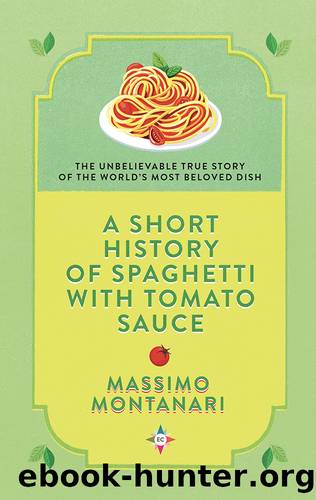A Short History of Spaghetti with Tomato Sauce by Massimo Montanari

Author:Massimo Montanari
Language: eng
Format: epub
Publisher: Europa Editions
Published: 2021-09-15T00:00:00+00:00
WHITE AND RED
Is amatriciana sauce white or red?
The tomato is one of those things that divides the world in two, and since white has become âold style,â it is not hard to deduce that in the history of gastronomy there is a before and an after the introduction of the tomato. But the process has been rather long and full of twists and turns, and it is not possible to mark an exact point on the time line that divides the two periods.
For centuries, pasta was rigorously served white. Cheese (with the addition of butter and spices for those who could afford them) was its most customary condiment. The use of lard and, sometimes, oil has also been attested. But the color was always white. That changed with the arrival of tomato sauce, but it arrived late, not before the 1800s. Goethe, who was in Naples in 1787, notes that âthe macaroni [ . . . ] are cooked simply in water and are dressed with grated cheese.â98 At that time, the tomato had been known for centuries, and we have to explain not only what factors led to its finally being used but also why it took so long.
Original to the western coasts of South America, where it still grows wild, the tomato enjoyed an extraordinary success among the Maya and the Aztecs. It was in Mexico that it met up with the Spaniards of Hernán Cortés, when they occupied the country between 1519 and 1521. It was immediately taken to Spain and thatâs how the tomato came to be grafted onto the gastronomic culture of Italy. Naturalists and botanists are the first to mention it, starting with Pietro Andrea Mattioli (1544) who cites it in his commentary on the pharmacological text of Pedacio Dioscoride.99 Of these ânew plants just arrived in Italy,â Mattioli describes the appearance and color, red or golden, explaining that they can be sliced and cooked like eggplant, that is, in a frying pan, and dressed with salt, olive oil, and black pepper. Just ten years later, in a new edition of the book, he would give these plants a name, âpomi dâoroâ (golden pomes), which would become the established name in Italian (while Spanish and the other major European languages would use names derived from the Aztec tomatl).
Tomatoes, then, are treated like eggplants. This association, justified on the botanical level by their common belonging to the Solanaceae family, would be adopted by subsequent writers and it would not have a positive influence on the image of the tomato, given the prejudices against the eggplant, known in Italian as melanzana or mela (apple) insana (insane or unhealthy).100 Pietro Antonio Michiel goes so far as to classify these âpomes from Peruâ as a variety of eggplant and repeats, like Mattioli, that they are to be cooked in a frying pan âwith butter or oilâ but that they are âharmful and noxiousâ; their very odor causes âtorment to the eyes and the head.â101 Castore Durante (1585) also
Download
This site does not store any files on its server. We only index and link to content provided by other sites. Please contact the content providers to delete copyright contents if any and email us, we'll remove relevant links or contents immediately.
Machine Learning at Scale with H2O by Gregory Keys | David Whiting(4106)
Never by Ken Follett(3762)
Fairy Tale by Stephen King(3193)
The Man Who Died Twice by Richard Osman(2979)
Will by Will Smith(2770)
Friends, Lovers, and the Big Terrible Thing by Matthew Perry(2100)
The Becoming by Nora Roberts(2062)
A Short History of War by Jeremy Black(1744)
Go Tell the Bees That I Am Gone by Diana Gabaldon(1670)
515945210 by Unknown(1583)
A Game of Thrones (The Illustrated Edition) by George R. R. Martin(1563)
443319537 by Unknown(1451)
The 1619 Project by Unknown(1366)
Works by Richard Wright(1247)
Meditations (Modern Library) by Marcus Aurelius(1229)
Going There by Katie Couric(1140)
472244821 by Unknown(1129)
book title by 2023(1084)
264099364 by Unknown(1041)
